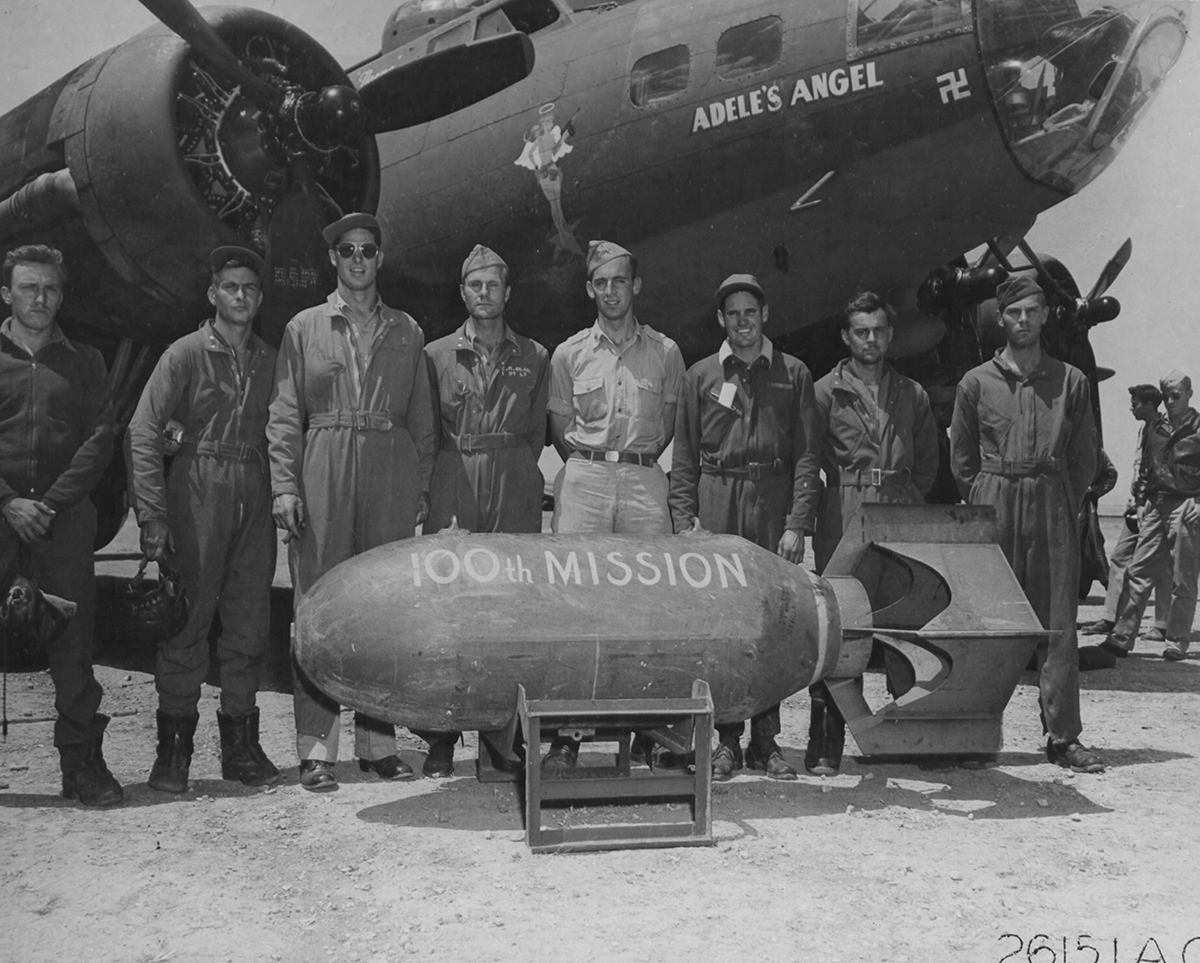
42-5456 / Adele’s Angel
Delivered Cheyenne 10/12/42; New Castle 19/12/42; Assigned 419BS/301BG Biskra 3/1/43; Ain M’Lila 17/1/43; St Donat 6/3/43; Oudna 6/8/43; Cerignola 7/12/43; Lucera 1/2/44; {53m} Salvaged 8/7/44.
 English
English Deutsch
DeutschThe main difference between the E and F models was the wider propeller blades with which the new model was equipped and which gave it better flight performance. The F model was produced in much larger numbers by three different manufacturers. Minor changes in details were made at each factory. The manufacturer was encoded in a suffix added to the model and block: BO stood for Boeing, VE for Lockheed Vega, and DL for Douglas. This made it clear that an aircraft with the designation “B-17F-50 VE” had been manufactured by Lockheed.
![B-17F-30-BO #42-5077 'Delta Rebel No. 2' // [Public domain], via Wikimedia Commons](https://b17flyingfortress.de/cms/wp-content/uploads/2018/08/b-17_42-5077_-600x401.jpg)
B-17F-30-BO #42-5077 ‘Delta Rebel No. 2’ // [Public domain], via Wikimedia Commons
“To find out at the beginning as us tried as one attacks the B-17 best, tried we bomb to and so on everything, even the bombers bombs. But we found out that the best tactics consisted in attacking her from the front and we used the 190s for it as end of ’43. The time at which you could shoot was very short since the approach-speed was very high. But, when you have hit the B-17 from the front, you have hit the cockpit or the engines mostly. There were only four 190s groups after this time which attacked from behind, which were called the “storm troops”. If the B-17 didn’t burn or the garrison didn’t jump down, then these 190s rammed the bombers at the tail unit or the rudder.”
Walter Krupinski
![Bundesarchiv, Bild 101I-657-6304-24 / Meschke / CC-BY-SA 3.0 [CC BY-SA 3.0 de (http://creativecommons.org/licenses/by-sa/3.0/de/deed.en)], via Wikimedia Commons](https://b17flyingfortress.de/cms/wp-content/uploads/2015/12/Bundesarchiv_Bild_101I-657-6304-24_Luftwaffe_Modelle_eines_Bombers_und_Jägers.jpg)
Bundesarchiv, Bild 101I-657-6304-24 / Meschke / CC-BY-SA 3.0 [CC BY-SA 3.0 de (http://creativecommons.org/licenses/by-sa/3.0/de/deed.en)], via Wikimedia Commons
By November 1942, the Luftwaffe fighter pilots had realized that they could attack a B-17F head-on and be safe from return fire from the actual plane. The fitted 0.30-calibre michine gun in the plexiglass nose was ineffective so individual Bomber Groups decided to replace it with the more destructive 0.50-calibre guns. A nose gun installation kit was provided by 8th Air Force Service Command and the importance of a forward mounted turret on a B-17 was impressed upon the manufacturers. The work on converting the nose turret was very slow and could be only be carried on when the aircraft was free from combat commitments. It was not until May 1943 that B-17F’s with a factory fitted nose gun mount landed in Britain.
“The Germans got to the beginning of the war from the side or behind. But they got for a lot counter-intelligence fire at 25 to 30 B-17s. When they found out that the B-17 had less fire strength in the nose, they changed the tactics. You came in V formations of the front. For us it looked like a line, now and then, however, they came in the inverted V and we shot onto the middle which, however, wasn’t in range yet. At the next trace it was a normal V perhaps again and the middle was nearer than the outer positions. These came toward us with really high speed. You came with 400 miles and we flew 160 and fired her with her 20 mm cannons on the cockpits as soon as we were within range in the hope to meet something. One could see coming the 20 mm and one hoped that they didn’t meet. After the attack they shifted and came back. Only if they found a single machine, they were not effective from the front, they then came back from the side or behind. A machine at which one or two engines had failed was alone put on herself and the guys of the air force took their time to hit the fuel tanks on the two fuselage sides.”
Robert Davila, Pilot der USAAF
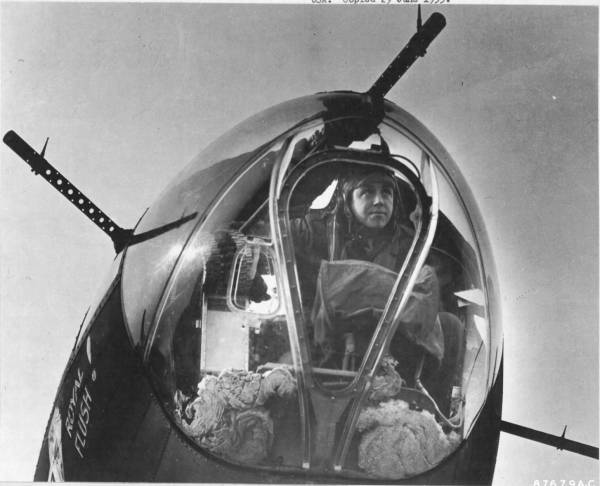
www.americanairmuseum.com// CC-BY-NC 3.0
“At the beginning only the Fw 190 attacked the bombers and the Bf 109 only was used as escort. Most attacks were flown from the front. If the bombers noticed that the 190s came, they often flew a curve from 10 or 15 degrees. This made it hard to come flying up from the front again.”
Walter Krupinski
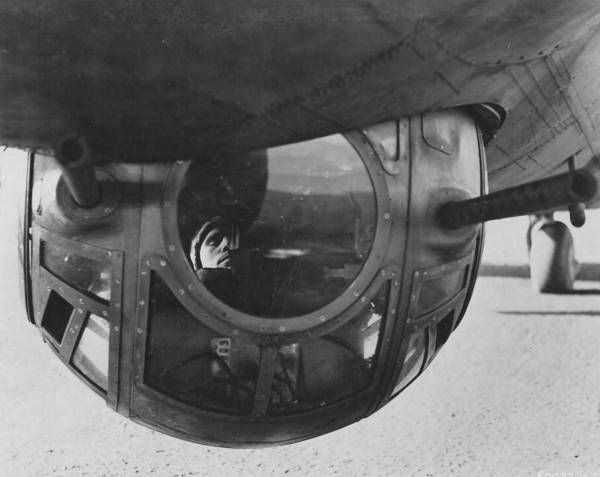
Ball Turret Gunner
The failure of the ball turret was of greater concern on the early models. Apart from the problem with retaion, the oxygen line, throat microphone, and flying suit heater cords all became tangled during normal combat operations. The gunner also feced the risk of running out of oxygen. The bottle contained insufficient oxygen for a normal mission and it was the job of the waist gunner to re-charge the ball turret cylinder but the valve often froze open and supply quickly emptied.
Other Problems included a leaking hydraulic unit, and a turret door that was prone to cracking. Getting out of the turret in an emergency was also a painfully slow procedure. The gunner had to hand-crank the turret in to the correct position, then lift himself out of the hatch and put on a parachute. Needless to say ball turret gunner was the least popular job amoung B-17 crews.
By May 1943, the US VIII Bomber Command had listed a dozen priorities for standard modifications: nose gun fittings, upper turret charging handles, armor plate protection for the pilot’s panel, more ammunitin for the gun in the radio room, an increase in the oxygen supply to all turrets, new radio antennae, Mark III IFF sets, a remote indicating compass and a life-raft realease. there was also a list of less important changes such as bullet proof glass in windows, re-locating waist gun sites for a better field of fire, fitting of GEE and changes to the oxygen system.
The cold conditions the aircraft operated in tended to freeze the bomb bay doors and the bomb shackles. In early missions this problem was overcome by one of the crew using a crow bar on on the frozen mechanism. Experienced crews would test the bomb bay door operation before they were on the bomb run.
Nothing could be done to stop the plane from being tail heavy but crews were warned about storing equipment and ammunition near the rear.
Another cause for condern was the ability of the waist gunners to inadvertently fire into the wing and tail. In July 1943 an electrical cut off system was fitted which automaticlly stopped the gun firing pins if the gun was aimed at any part of the plane.
One of the most important changes in the development of the B-17F was the addition of extra fuel tanks giving the plane another 1080 US gallons. effectively, this increased the B-17F’s range by 1000 miles and the operational radius doubled to 650 miles. The extra fuel units were called “Tokyo Tanks” (supposedly adding enough range so that a B-17 could get to Tokyo from a carrier in the Pacific) and were made up of nine rubber self-sealing cells placed betwenn of ribs of both wings. These long-range versions first appeared at English bases in May 1943.

Delivered Cheyenne 10/12/42; New Castle 19/12/42; Assigned 419BS/301BG Biskra 3/1/43; Ain M’Lila 17/1/43; St Donat 6/3/43; Oudna 6/8/43; Cerignola 7/12/43; Lucera 1/2/44; {53m} Salvaged 8/7/44.
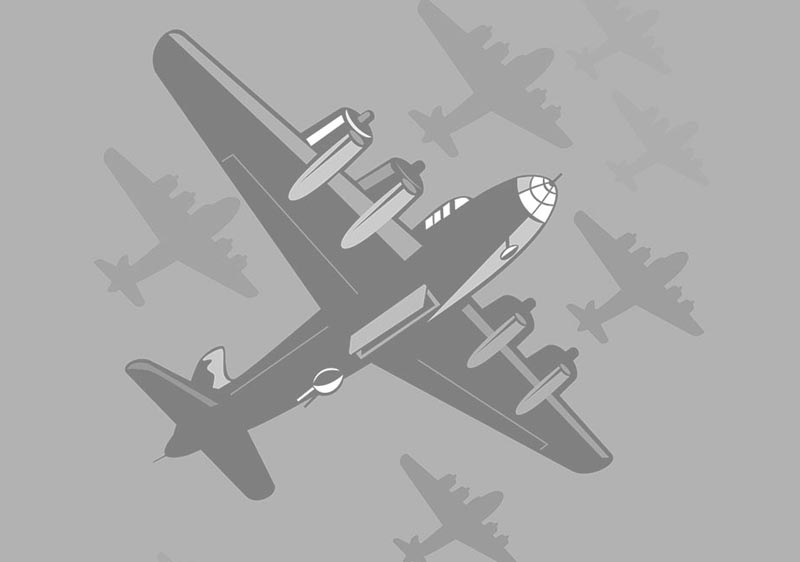
Delivered Cheyenne 1/4/43; Pueblo 8/4/43; Smoky Hill 6/5/43; Dow Fd 19/5/43; Assigned: 532BS/381BG [VE-E] Ridgewell 22/5/43 Pilot: Bill Morre, Dale Wendte, Phil Dreiseszun, Jim Houck, Frank Bryant, Ed Usher, Bill Kithcart, Bill Fortier, Edgerton Zahm, John Watkins; MIA {1m} Hamburg 24/7/43 w/Bill Moore, Navigator: Phillip Dreiseszun, Radio Operator: John Ivey, Engineer / Top Turret Gunner: Ed Usher, Ball Turret Gunner: Edgerton Zahm, Waist Gunner: Bill Fortier (6POW); Co-Pilot: Dale Wendte, Bombardier: Jim Houck*, Waist Gunner: Joe Kralick, Tail Gunner: John Watkins* (4KIA – * went down in ship); flak hit #1 & #2, wing blazed; crashed Neustadt Bay, Germany. MACR 130. LETHAL LADY.

Delivered Denver 9/4/43; Gore 10/4/43; Denver 27/4/43; with Bill Stenson force landed Tinker, Ok 1/5/43; Gt Falls 25/5/43; Assigned 25FS/7FG with Bill Stenson force landed Tinker, OK 30/4/43; Kearney 29/5/43; Dow Fd 16/6/43; Assigned 418BS/100BG [LD-S] Thorpe Abbotts 17/6/43; damaged in base explosion at Gt Ashfield 3/9/43; crash landed Eye, Sfk. UK, 21/4/44, on training flight with Myron Richmond (all of 349BS), Co-pilot: John Kenney, Navigator: Gus Horstmann, Bombardier: Bob Keagy, Flight engineer/top turret gunner: Lester Cutler, Radio Operator: Walter George, Ball turret gunner: Chas Lewis, Waist gunner: John Johnson, Waist gunner: Cornelius Robinson,Tail gunner: Ray Lilly (10 Killed in Service); mission abandoned and ship suddenly dived to crash on butts of Eye Afd, Sfk., beside A140 Ipswich-Norwich Rd; Salvaged 5/5/44. BLIVIT.

Delivered Long Beach 13/7/43; Cheyenne 17/7/43; 248 BU Walker 4/6/44; 232 BU Dalhart 11/7/44; 248 BU Walker 25/1/45; 4112 BU Olmstead 23/7/45; 248 BU Walker 5/8/45; Reconstruction Finance Corporation (sold for scrap metal in USA) Santa Maria 22/9/45. US Civil N7942A; to Bolivia CP-686; Trinidad, Bolivia 4/11/65, Written off 11/1968.

Delivered Long Beach 17/4/43; New Castle 30/4/43; Presque Is 6/5/43; Assigned: 333BS/94BG [TS- ] Earls Colne 14/5/43; Rougham 13/6/43; MIA Huls 22/6/43 Pilot: John Sabella, Co-Pilot: Delbert Long, Navigator: Joe Gaudette, Bombardier: Warren Tinker, Engineer / Top Turret Gunner: Bob Hardin, Radio Operator: Gustav Eliason, Ball Turret Gunner: Don Benner, Waist Gunner: Alf Galasso, Waist Gunner: Chas Stimpson, Tail Gunner: Leroy Blocker (10POW); direct flak hit, Enemy aircraft, crashed two miles E of Opheusden, Germany. No MACR.

Delivered Cheyenne 24/4/43; Smoky Hill 5/5/43; Dow Fd 25/5/43; Assigned 412BS/95BG [QW-H] Horham 15/6/43; 10m, severe battle damaged Schweinfurt 17/8/43 with Don Eastling, rest unknown; Salvaged 24/8/43. WEE BONNIE.
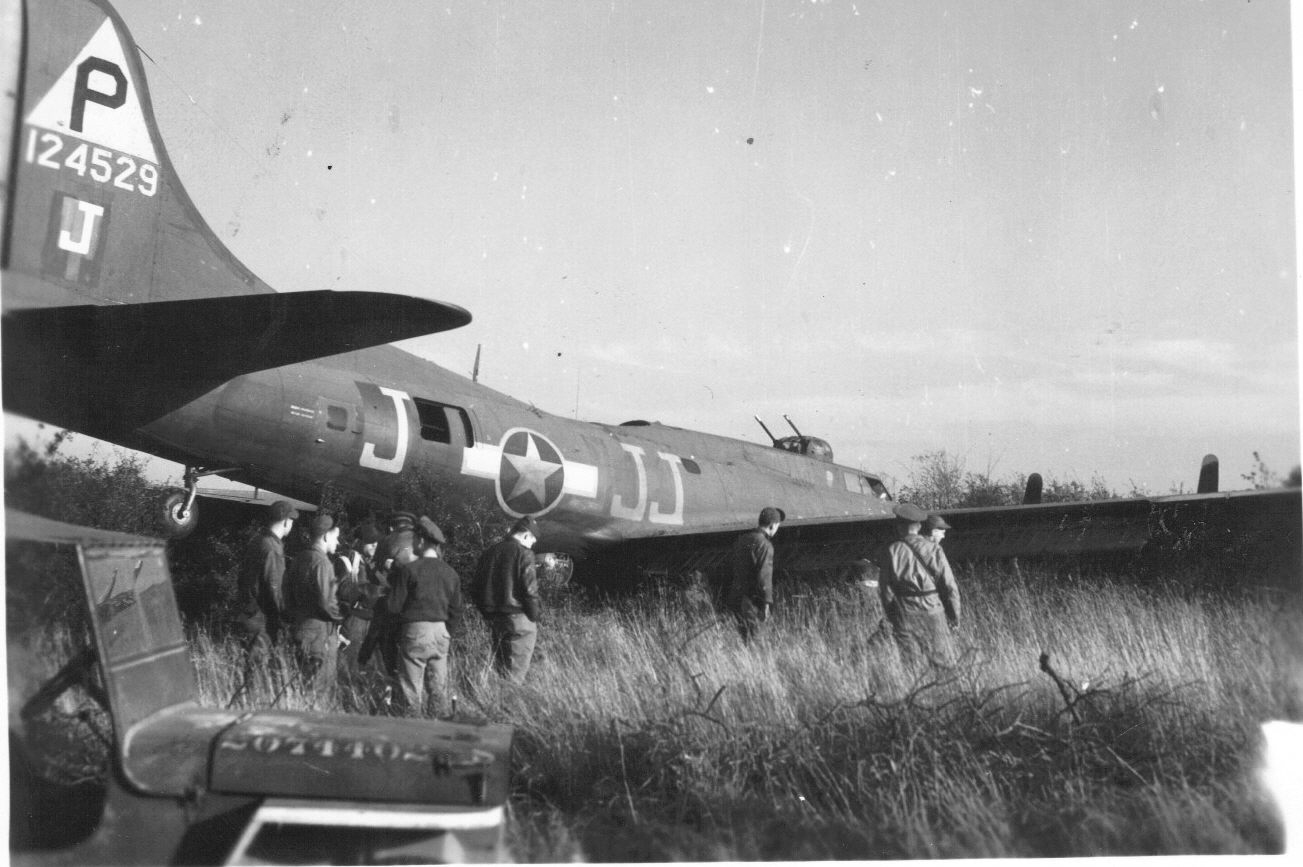
Assigned 422BS/305BG [JJ-T] Syracuse 14/9/42; Grafton Underwood 25/10/42; transferred 546BS/384BG Grafton Underwood [BK-J] 22/9/43; on engine check mission 9/10/43, overshot runway and into a ditch, undercarriage collapsing & blocking nearby road, with John Berbrich (?Willing?), Co-pilot: Francis Nelson, Navigator: Julius Schwartz, Flight engineer/top turret gunner: Gil Jacobs (4 Returned to Duty); enquiry resulted in 100% pilot error; Salvaged 17/10/43.

Delivered Boeing 8/7/43; 11AF Ladd Fd, Alaska, cold weather testing 9/9/43, with Jim Aubrey, crash landed on the tundra 14 miles SE Ruby, AK, 25/9/43. Found in 1996 by Gary Larkins, who returned on 2001 for more parts.

Delivered Cheyenne 6/4/43; Ephrata 30/7/43; with Howard Towers force landed 10 miles W of Ardmore 2/12/43; transferred 244 BU Harvard 28/7/44; 242 BU Alliance 21/10/44; 233 BU Davis-Monthan 1/2/45; Reconstruction Finance Corporation (sold for scrap metal in USA) Ontario 15/6/45.

Delivered Cheyenne 15/4/43; Morrison 4/5/43; Warner Robins 10/5/43; Morrison 19/5/43; Assigned 346BS/99BG Navarin 30/5/43; battle damaged Messina 25/6/43 with Lippman; #1 & 2 engines out; Oudna 4/8/43; transferred 97BG Depienne 14/11/43; Cerignola 20/12/43; Amendola 16/1/44; Salvaged 8/7/44. CREW NO. 1.
Search for B-17
Supporting
Do you like this website about the B-17 Flying Fortress? I could help you find the information you are looking for? I would be very pleased if you would support my work with PayPal Me!
B-17 Store by teespring
Masters of the Air
 Buy on Amazon*
Buy on Amazon*
* = CommissionsEarned. As an Amazon Associate I earn from qualifying purchases.
Recent Comments
Information